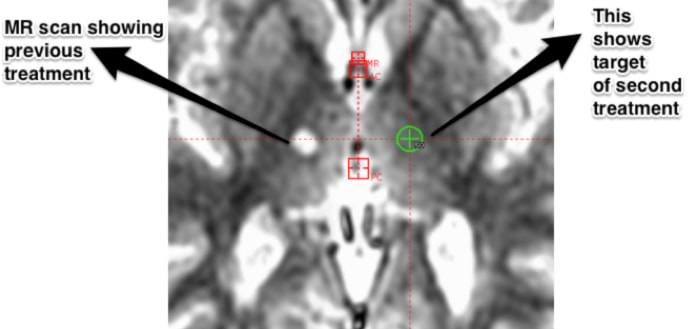Essential Tremor
Essential tremor (also called familial tremor or benign essential tremor) is a common movement disorder. In fact, it is six times more common than Parkinson’s disease. It is frequently confused with Parkinson’s disease; while it is true that some patients have both, it is important to distinguish the two conditions. Essential tremor is an action tremor—this means the shaking increases when one tries to use the muscles; in Parkinson’s disease, the tremor is usually a resting tremor and the patient may also have rigidity and stiffness.

Essential tremor usually involves the hands. Typically the has a rhythm of 4-12 Hz . Using a ruler or a scissors can become difficult. As the tremor worsens, driving, feeding, dressing (buttoning clothes) can become nearly impossible. Stress may worsen the tremor. Tremor may also involve the voice; in early stages singing (vibrato only) may be a symptom, but as the condition worsens, it may also make speech (especially on the telephone) difficult to understand.
In some people, the tremor may also involve the head, or jaw. These patients may also have a tremulous voice which makes talking on the telephone particularly difficult. For unknown reasons, women seem more at risk to develop head tremor than men. Some patients may also have trouble with walking and balance.
While the cause of essential tremor is unknown, half the patients have a family history implying a genetic mutation that is inherited in an autosomal dominant pattern.
Treatment of essential tremor begins with medications—beta blockers and the anti-seizure medicine primidone are effective. Other anti-epileptics may be tried but are often less successful.
When activities of daily living are significantly impaired, surgical treatments may be offered. Deep brain stimulation (DBS) involves placement of electrodes in the brain—the electrodes are attached to electrical generators that block the tremor center in the thalamus. Deep brain stimulation has the advantage of being a reversible operation (that is the generator can be turned off). However, many patients have other medical problems (anti-coagulation, diabetes, heart disease) which increase the risk of the procedure. In addition, patients with deep brain stimulators may require additional surgery to replace batteries, repair broken electrode wires or deal with infections.
Gamma knife radiosurgery (thalomotomy) is equally effective as deep brain stimulation. In this procedure, the gamma knife is used to make a small lesion in the tremor center. Treatments are done one side at a time with a year between treatments. The effect is usually seen within a few months after treatment.

Our Experience with Gamma Knife Treatment of Essential Tremor
We were pioneers in treatment of Essential Tremor (and other types of tremor) with the gamma knife. The first patients were treated in1991 and over the years since then, we have used the Gamma Knife to treat over 1,000 patients with Essential Tremor. We have published results of our treatments in peer-reviewed literature.
- In 2000 we reported in the Journal of Neurosurgery the results of gamma knife thalamotomy on 158 patients with tremor. These patients were evaluated before and after treatment by a team of independent examiners. The study confirmed relief of tremor for both parkinsonian tremor as well as tremor due to essential tremor. Read More
- In 2010, we presented results of 214 Gamma Knife thalamotomy procedures for treatment of essential tremor also in the Journal of Neurosurgery. Read More
- In 2014, we presented a study of bilateral (both sides) gamma knife thalamotomy for axial tremor symptoms. Axial tremor symptoms means tremors involving the head, neck, lower jaw or voice. We studied 68 patients with axial tremor and noted that these symptoms could be alleviated after bilateral treatments with a similar success rate to that reported for deep brain stimulation but with a lower complication rate. Read More